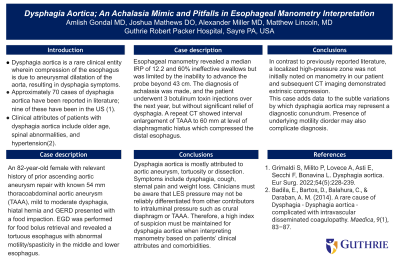Back


Poster Session E - Tuesday Afternoon
Category: Esophagus
E0220 - Dysphagia Aortica: An Achalasia Mimic and Pitfalls in Esophageal Manometry Interpretation
Tuesday, October 25, 2022
3:00 PM – 5:00 PM ET
Location: Crown Ballroom

Has Audio
- AG
Amlish Gondal, MD
Guthrie Robert Packer Hospital
Sayre, PA
Presenting Author(s)
Amlish Gondal, MD, Joshua Mathews, DO, Alexander Miller, MD, Matthew Lincoln, MD
Guthrie Robert Packer Hospital, Sayre, PA
Introduction: Dysphagia aortica is a rare clinical entity wherein compression of the esophagus is due to aneurysmal
dilatation of the aorta, resulting in dysphagia symptoms. Approximately 70 cases of dysphagia aortica
have been reported in literature; nine of these have been in the US. Clinical attributes of dysphagia
aortica include older age, spinal abnormalities, and hypertension.
Case Description/Methods: This is an 82-year-old female with relevant history of prior ascending aortic aneurysm repair with known
54 mm thoracoabdominal aortic aneurysm (TAAA), mild to moderate dysphasia, hiatal hernia and GERD
presented with a food impaction. EGD was performed for food bolus retrieval and revealed a tortuous
esophagus with abnormal motility/spasticity in the middle and lower esophagus. Esophageal
manometry revealed a median IRP of 12.2 and 60% ineffective swallows but was limited by the inability
to advance the probe beyond 43 cm. The diagnosis of achalasia was made, and the patient underwent 3
botulinum toxin injections over the next year, but without significant relief of dysphagia. A repeat CT
showed interval enlargement of TAAA to 60 mm at level of diaphragmatic hiatus which compressed the
distal esophagus.
Discussion: Dysphagia aortica is mostly attributed to aortic aneurysm, tortuosity or dissection. Symptoms include
dysphagia, cough, sternal pain and weight loss. Clinicians must be aware that LES pressure may not be
reliably differentiated from other contributors to intraluminal pressure such as crural diaphragm or
TAAA. Therefore, a high index of suspicion must be maintained for dysphagia aortica when interpreting
manometry based on patients’ clinical attributes and comorbidities. In contrast to previously reported
literature, a localized high-pressure zone was not initially noted on manometry in our patient and
subsequent CT imaging demonstrated extrinsic compression – adding to the subtle variations by which
dysphagia aortica may represent a diagnostic conundrum.
Disclosures:
Amlish Gondal, MD, Joshua Mathews, DO, Alexander Miller, MD, Matthew Lincoln, MD. E0220 - Dysphagia Aortica: An Achalasia Mimic and Pitfalls in Esophageal Manometry Interpretation, ACG 2022 Annual Scientific Meeting Abstracts. Charlotte, NC: American College of Gastroenterology.
Guthrie Robert Packer Hospital, Sayre, PA
Introduction: Dysphagia aortica is a rare clinical entity wherein compression of the esophagus is due to aneurysmal
dilatation of the aorta, resulting in dysphagia symptoms. Approximately 70 cases of dysphagia aortica
have been reported in literature; nine of these have been in the US. Clinical attributes of dysphagia
aortica include older age, spinal abnormalities, and hypertension.
Case Description/Methods: This is an 82-year-old female with relevant history of prior ascending aortic aneurysm repair with known
54 mm thoracoabdominal aortic aneurysm (TAAA), mild to moderate dysphasia, hiatal hernia and GERD
presented with a food impaction. EGD was performed for food bolus retrieval and revealed a tortuous
esophagus with abnormal motility/spasticity in the middle and lower esophagus. Esophageal
manometry revealed a median IRP of 12.2 and 60% ineffective swallows but was limited by the inability
to advance the probe beyond 43 cm. The diagnosis of achalasia was made, and the patient underwent 3
botulinum toxin injections over the next year, but without significant relief of dysphagia. A repeat CT
showed interval enlargement of TAAA to 60 mm at level of diaphragmatic hiatus which compressed the
distal esophagus.
Discussion: Dysphagia aortica is mostly attributed to aortic aneurysm, tortuosity or dissection. Symptoms include
dysphagia, cough, sternal pain and weight loss. Clinicians must be aware that LES pressure may not be
reliably differentiated from other contributors to intraluminal pressure such as crural diaphragm or
TAAA. Therefore, a high index of suspicion must be maintained for dysphagia aortica when interpreting
manometry based on patients’ clinical attributes and comorbidities. In contrast to previously reported
literature, a localized high-pressure zone was not initially noted on manometry in our patient and
subsequent CT imaging demonstrated extrinsic compression – adding to the subtle variations by which
dysphagia aortica may represent a diagnostic conundrum.
Disclosures:
Amlish Gondal indicated no relevant financial relationships.
Joshua Mathews indicated no relevant financial relationships.
Alexander Miller indicated no relevant financial relationships.
Matthew Lincoln indicated no relevant financial relationships.
Amlish Gondal, MD, Joshua Mathews, DO, Alexander Miller, MD, Matthew Lincoln, MD. E0220 - Dysphagia Aortica: An Achalasia Mimic and Pitfalls in Esophageal Manometry Interpretation, ACG 2022 Annual Scientific Meeting Abstracts. Charlotte, NC: American College of Gastroenterology.
